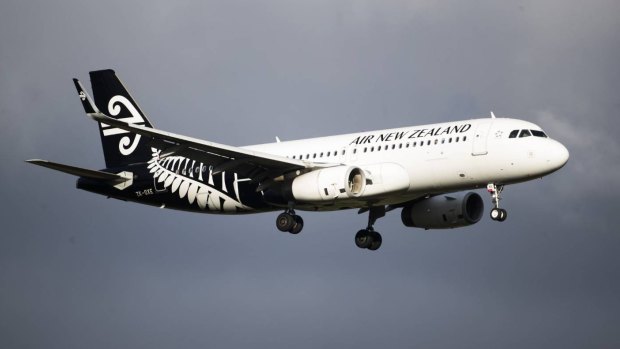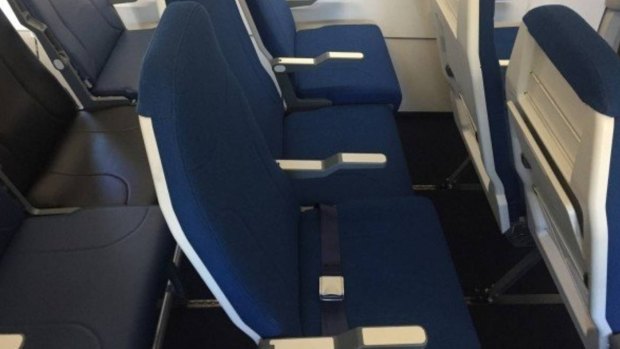This was published 3 years ago
Covid-19 and plane travel: Woman 'shocked' by passengers packed into Air New Zealand flight
By Lorna Thornber

Passengers on the domestic flight were "jammed in like sardines". Credit: Stuff
An Auckland woman was "shocked" to find passengers seated closer than two metres together on a recent Air New Zealand flight, describing the lack of adherence to general physical distancing rules as "extraordinary".
A spokesperson for Air New Zealand, however, said the airline is "strictly following Ministry of Health and World Health Organisation (WHO) guidelines".
Christine, who did not want her surname published, said her Tuesday afternoon flight from Auckland to Wellington was "full".

SUPPLIED Some airlines are keeping the middle seats free to reduce contact between passengers. Credit: Stuff
While the middle seats were kept empty, passengers sat directly in front of, behind and across the aisle from one another, she said.
"I was really shocked. Really shocked given that the Government is saying we should stay at least two metres apart. We were jammed in like sardines. We had someone right in front of us and someone right behind us."
"Given the extreme lengths small businesses have to go to to be able to trade, it seems extraordinary that Air New Zealand can just ignore the government instructions of two-metre social distancing."
As passengers had booked their seats in advance, Christine said couldn't "see what their excuse could be. There was ample opportunity to get the places prepared."
Passengers did not stick to physical distancing rules during boarding either, she said.
"Everyone queued up as they did in pre-Covid days. If someone left a gap, another passenger would dart into it."
The Government's general rule on physical distancing under alert level three is the same as it was under alert level four: "Outside of your home, you must continue to keep a 2 metre distance from people at all times."
An Air New Zealand spokesperson said the airline is "strictly following Ministry of Health and WHO guidance to ensure all flights are safe for crew and our customers".
The Ministry of Health sets the guidelines for travel under the various alert levels.
"This includes supporting physical distancing onboard by allocating seating to allow for extra space between passengers. Blocks are currently in place for the middle seats on our domestic jets and aisle seats on turboprop services.
"Due to the travel restrictions under Level 3, most domestic flights currently have very few passengers and these passengers are spaced out through the entire cabin."
The carrier allows people in the same "bubble" to sit together if they wish to but will space them apart if they prefer, the spokesperson said.
There were 131 passengers aboard the Airbus A321 Neo that flew to Wellington on April 28 and the aircraft can seat 214, she said.
"With physical distancing onboard (assuming no groups of 'bubbles' sitting together) we can carry up to 140 passengers on this aircraft."
Air New Zealand is among multiple airlines internationally to have left middle seats empty on flights since the coronavirus outbreak.
The national carrier says on its website that it "will be physically distancing passengers from each other and from crew when capacity allows... To help maximise available seating we're keeping families and some travelling companions together."
For privacy reasons, the airline will not tell passengers if they are sitting next to someone who has travelled on an international flight. However it advises them to "rest assured we're doing everything possible to provide a safe level of social distancing for all our customers."
The seat pitch on the A321 Neo is between 74 and 83 centimetres, meaning passengers are seated less than a metre apart from those directly in front of and behind them.
While keeping middle seats empty may help reassure travellers, some experts do not think it is viable long-term.
"In the longer run, it will not be feasible for airlines to practice physical distancing on board," Auckland University of Technology tourism professor Michael Lueck said.
To maintain a 1.5- to two-metre distance between passengers in economy class, only alternate rows could be used, he noted.
Aviation expert Irene King said removing the middle seats on flights "will make the cost of air travel prohibitive, as will social distancing. Operating aircraft at 55 to 65 per cent capacity will simply send aviation broke."
To circumvent this, much work is being done on alternative means to protect passengers on board, including enhanced cleaning and sanitation processes.
Air New Zealand says it is sanitising its aircraft with stronger products that it used before the Covid-19 pandemic and that its jet aircraft have hospital-grade air systems which filter out viruses.
Shashank Nigam, chief executive of Singapore-based aviation consultancy SimpliFlying, said Covid-19 is likely to prompt "a new age of sanitised air travel" that will see passengers pass through disinfection tunnels at airports, undergo heath checks and have their bags "sanitagged".
"Getting large numbers of people flying again will depend on giving them the peace of mind that they won't be rubbing shoulders - or bumping elbows in economy - with infectious fellow travellers.
"In addition, government authorities and airport operators will want to know that airlines adhere to a certain standard of cleanliness and hygiene before offering up landing slots."
Nigam believes there needs to be a single authority to set down global standards on health-related matters at the airport and on aircraft.
"Similar to the creation of the US Transportation Security Administration (TSA) after 9/11, I believe there will need to be a global THA – Transportation Health Authority.
"This will have to be managed by the International Civil Aviation Organisation, the World Health Organisation and Airports Council International.
"In an ideal situation, we want consistent health screenings and policies around the world, because inconsistency will only frustrate travellers more and suppress demand."
See also: AirAsia unveils new flight attendant uniforms for COVID-19
See also: New coronavirus hygiene rules could send airfares sky-high
Sign up for the Traveller newsletter
The latest travel news, tips and inspiration delivered to your inbox. Sign up now.